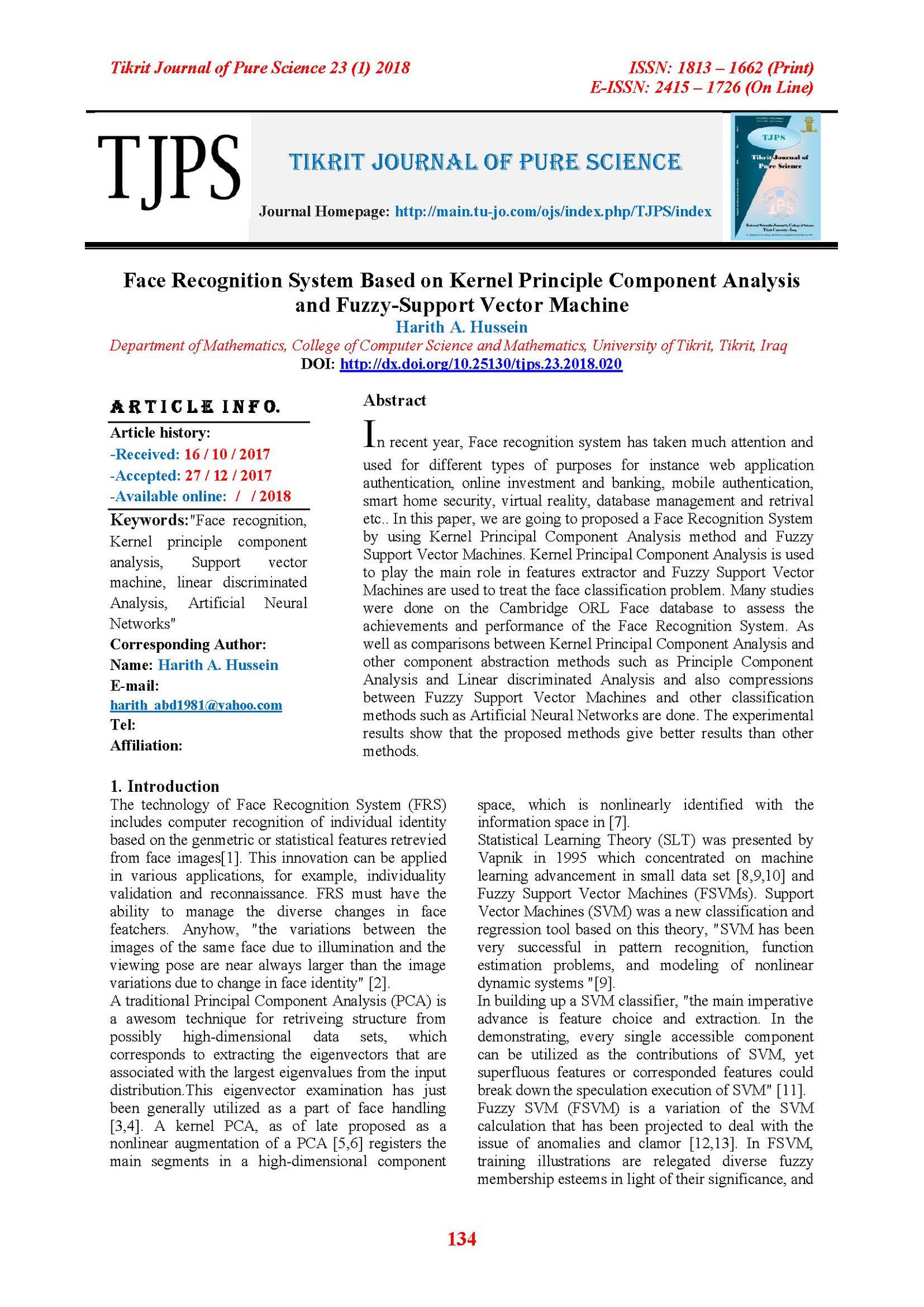Face Recognition System Based on Kernel Principle Component Analysis and Fuzzy-Support Vector Machine
Main Article Content
Abstract
In recent year, Face recognition system has taken much attention and used for different types of purposes for instance web application authentication, online investment and banking, mobile authentication, smart home security, virtual reality, database management and retrival etc.. In this paper, we are going to proposed a Face Recognition System by using Kernel Principal Component Analysis method and Fuzzy Support Vector Machines. Kernel Principal Component Analysis is used to play the main role in features extractor and Fuzzy Support Vector Machines are used to treat the face classification problem. Many studies were done on the Cambridge ORL Face database to assess the achievements and performance of the Face Recognition System. As well as comparisons between Kernel Principal Component Analysis and other component abstraction methods such as Principle Component Analysis and Linear discriminated Analysis and also compressions between Fuzzy Support Vector Machines and other classification methods such as Artificial Neural Networks are done. The experimental results show that the proposed methods give better results than other methods.
Article Details

This work is licensed under a Creative Commons Attribution 4.0 International License.
Tikrit Journal of Pure Science is licensed under the Creative Commons Attribution 4.0 International License, which allows users to copy, create extracts, abstracts, and new works from the article, alter and revise the article, and make commercial use of the article (including reuse and/or resale of the article by commercial entities), provided the user gives appropriate credit (with a link to the formal publication through the relevant DOI), provides a link to the license, indicates if changes were made, and the licensor is not represented as endorsing the use made of the work. The authors hold the copyright for their published work on the Tikrit J. Pure Sci. website, while Tikrit J. Pure Sci. is responsible for appreciate citation of their work, which is released under CC-BY-4.0, enabling the unrestricted use, distribution, and reproduction of an article in any medium, provided that the original work is properly cited.
References
1. J. Daugman, “Face and gesture recognition: overview,” IEEE Trans. Pattern Analysis and Machine Intelligence, vol. 19, no. 7, pp. 675-676, 1997.
2. Y. Adini, Y. Moses, and S. Ullman, “Face recognition: the problem of compensating for changes in illumination direction,” in Proc.European Conf. Computer Vision, pp. 286-296, 1994.
3. M. Turk and A. Pentland, “Eigenfaces for recognition,” J. Cogn. Neurosci., vol. 3, no. 1, pp. 71–86, 1991.
4. J. Zhang, Y. Yan, and M. Lades, “Face recognition: Eigenface, elastic matching, and neural nets,” Proc. IEEE, vol. 85, pp. 1423–1435, Sept. 1997.
5. B. Schölkopf, A. Smola, and K. Müller, “Non-linear component analysis as a kernel eigenvalue problem,” Neural Comput., vol. 10, pp. 1299–1319, 1998.
6. K. Müller, S. Mika, G. Rätsch, K. Tsuda, and B. Schölkopf, “An introduction to kernel-based learning algorithms,” IEEE Trans. Neural Networks, vol. 12, pp. 181–201, Mar. 2001.
7. B. Schölkopf, A. Smola, and K. Müller, “Kernel principal component analysis,” in Advances in Kernel Methods-Support Vector Learning, B. Schölkopf, C. Burges, and A. Smola, Eds. Cambridge, MA: MIT Press, 1999, pp. 327–352.
8. Vapnik V, The Nature of Statistical Learning Theory. New York: Springer-Verlag, 1999.
9. Vapnik V. “An Overview of Statistical Learning Theory”. IEEE Trans. on Neural Network, Vol. 10(5), pp. 988~999, 1999.
10. Zhang Xuegong. “Introduction to Statistical Learning Theory and Support Vector Machines”. Acta Automation Sinica, Vo1.26(1), pp. 32~41, 2000.
11. Qisong Chen, Xiaowei Chen and Yun Wu, "Optimization Algorithm with Kernel PCA to Support Vector Machines for Time Series Prediction", JOURNAL OF COMPUTERS, VOL. 5, NO. 3,pp. 380-386, MARCH 2010.
12. Batuwita R, Palade V. FSVM-CIL: fuzzy support vector machines for class imbalance learning. Fuzzy Systems, IEEE Transactions on. 2010; 18(3):558-571.
13. ArindamChaudhuri. Modified fuzzy support vector machine forcredit approval classification. AI Communications 27 189-21l, 2014.
14. Chris Solomon and Toby Breckon, Fundamentals of Digital Image Processing, First ed., John Wiley & Sons,2011.
15. Scholkopf, Bernhard, Smola, Alexander, and M uller, Klaus-Robert. Nonlinear component analysis as akernel eigenvalue problem. Neural computation, 10(5):12991319, 1998.
16. IgnasKukenys and Brendan McCane,” Support Vector Machines for Human Face Detection”,
NZCSRSC 2008, , Christchurch, New Zealand, April 2008.
17. http://cvc.yale.edu/projects/yalefaces/yalefaces.html
18. http://www.cl.cam.ac.uk/research/dtg/attarchive/facedatabase.html(URL)
